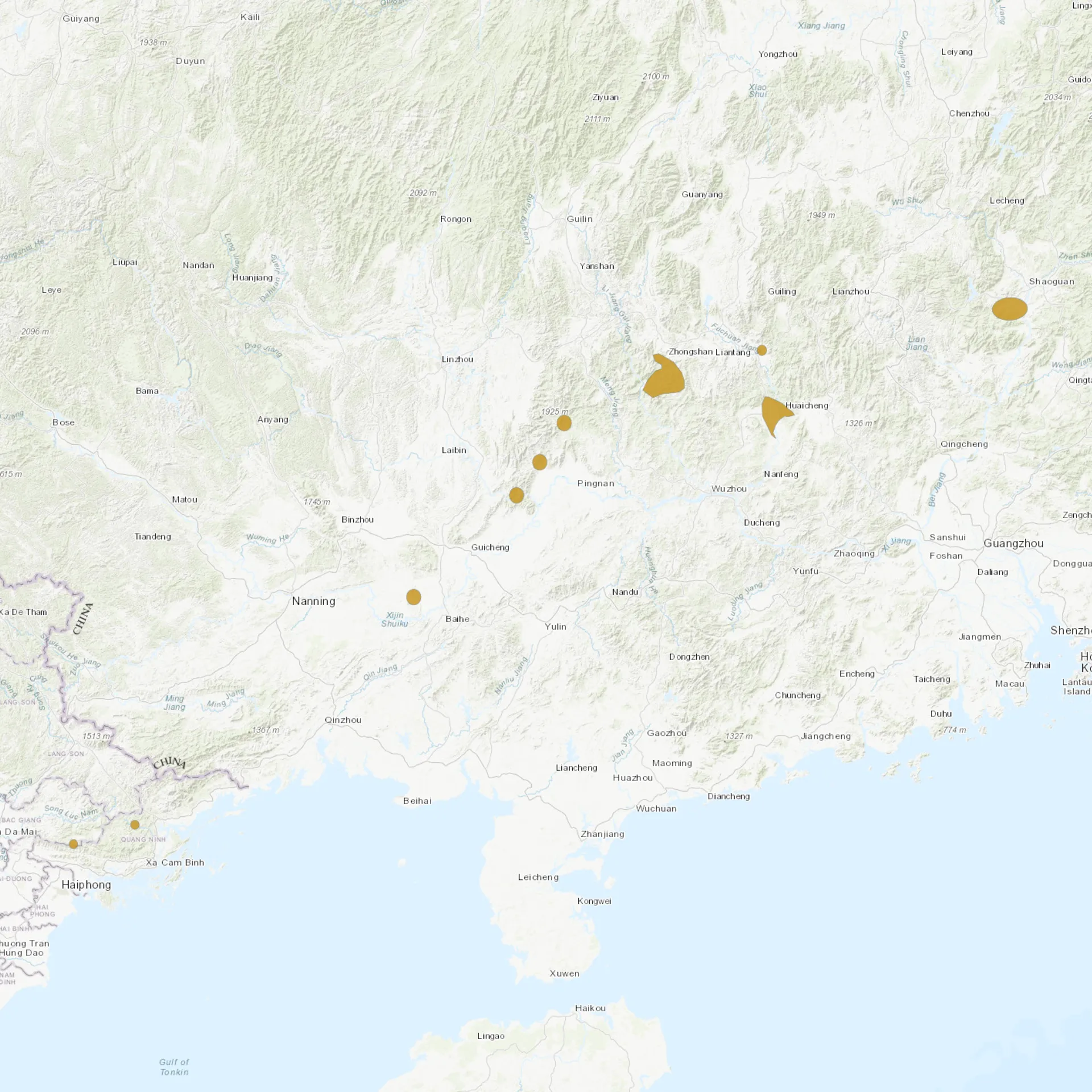Overview
The Chinese crocodile lizard (Shinisaurus crocodilurus) is a semiaquatic reptile known for its distinct crocodile-like appearance and slow-moving behavior. It is native to southern China and northern Vietnam, inhabiting subtropical forested streams and wetlands. This species is the only living member of the family Shinisauridae, making it a unique evolutionary relic. Its population is highly fragmented and has been significantly impacted by habitat destruction and illegal collection for the pet trade.
Chinese crocodile lizards are primarily diurnal but display unusual periods of inactivity, sometimes remaining motionless for hours. They are adept swimmers and rely on water as a primary refuge from predators and environmental threats. Their strong, muscular tails and robust limbs aid in climbing and maneuvering through their wetland habitats. Despite their reptilian cold-blooded nature, they can remain active in relatively cool temperatures compared to other lizards.
This species exhibits striking coloration, with a body covered in rough, keeled scales that enhance its resemblance to a miniature crocodile. It typically has an olive-brown dorsal coloration with dark crossbands along the back and tail. The sides of the body may feature bright orange or red markings, which are more pronounced in males. Juveniles are often duller in coloration, gradually developing their adult patterns as they mature.
Taxonomy
Kingdom
Phylum
Class
Order
Family
Genus
Species
Type
Current distribution:
The Chinese crocodile lizard is currently found in fragmented populations within southern China and northern Vietnam. In China, they primarily inhabit parts of Guangdong and Guangxi provinces, where suitable forested wetland habitats remain. In Vietnam, their range is even more restricted, with only small, isolated populations documented in select regions. Habitat destruction and illegal collection have caused severe declines, limiting their overall distribution.
Many historical populations have disappeared due to deforestation, pollution, and the draining of wetlands for agriculture. The remaining wild populations are scattered, and face continued threats from human encroachment. Conservation efforts have identified critical habitats for protection, but enforcement remains challenging. Due to their rarity and distinctive appearance, they are also at high risk of being captured for the exotic pet trade, further reducing wild numbers.
Physical Description:
The Chinese crocodile lizard has an elongated, laterally compressed body with a powerful tail that constitutes nearly two-thirds of its total length. Its head is broad and triangular, with a slightly pointed snout and large, round eyes with vertical pupils. The body is covered in overlapping, keeled scales, giving it a rough and armored appearance. These lizards have short but strong limbs with sharp claws, enabling them to climb and grip onto branches and rocks.
Their coloration varies between individuals, but most exhibit a brown to olive-green dorsal surface with dark bands across their backs and tails. Males tend to have brighter reddish or orange markings along their flanks and throats, while females and juveniles often display more muted tones. The underside is usually a pale yellowish or off-white, contrasting with the darker dorsal scales. This cryptic coloration helps them blend into their environment, providing camouflage against predators.

Lifespan: Wild: ~5 Years || Captivity: ~10 Years

Weight: Male & Female: 8.8–12.3 oz (250–350 g)

Length: Male & Female: 15.7–18.5 in (40–47 cm)

Top Speed: 5 mph (8 km/h)
Characteristic:
Native Habitat:
Chinese crocodile lizards are found in subtropical evergreen forests with access to slow-moving, shallow streams and ponds. They prefer habitats with dense vegetation, overhanging branches, and rocky areas where they can bask and seek shelter. Their semi-aquatic nature makes them highly dependent on clean, freshwater environments with stable temperatures and humidity. These lizards are often found clinging to branches or submerged near the water’s edge, using their surroundings for thermoregulation and protection.
The species thrives in areas with high humidity and moderate temperatures, typically 60–80°F (15–27°C). They require shaded environments with a mix of land and water, as they spend significant time basking and swimming. The presence of aquatic prey is a critical factor in their habitat selection, influencing their distribution and population density. Deforestation, pollution, and habitat modification have severely impacted their natural habitats, leading to population declines.
Climate Zones:
Biomes:
WWF Biomes:
Biogeographical Realms:
Continents:
Diet:
Diet & Feeding Habits:
The Chinese crocodile lizard is a carnivorous reptile with a diet of small aquatic and terrestrial invertebrates. It feeds on insects such as crickets, grasshoppers, beetles, worms, snails, and small fish. In captivity, they are often fed a diet supplemented by commercially available insects and the occasional pinky mouse. They rely on their sharp vision and ambush-hunting technique, remaining motionless before striking at unsuspecting prey.
They are opportunistic feeders, consuming whatever small prey they can overpower within their environment. Juveniles tend to eat a higher proportion of small insects and larvae, while adults may consume larger prey items. Their slow metabolism allows them to survive on relatively infrequent meals compared to other lizards of similar size. They often hunt near the edges of streams and water bodies when feeding in the wild, using aquatic and terrestrial hunting strategies.
Mating Behavior:
Mating Description:
The Chinese crocodile lizard is a viviparous species, giving birth to live young rather than laying eggs. Mating typically occurs in late spring to early summer, with females giving birth after a long gestation period. The species exhibits a relatively low reproductive rate, with females giving birth to 2–12 offspring yearly. Newborns are independent from birth and must fend for themselves in aquatic and terrestrial environments.
Males become more territorial and aggressive during the breeding season, displaying courtship behaviors such as head bobbing and body posturing. Females are selective and may reject multiple mating attempts before accepting a male. After birth, juveniles grow slowly, taking several years to reach sexual maturity. Due to their low reproductive output, any population decline significantly impacts their ability to recover.
Reproduction Season:
Birth Type:
Pregnancy Duration:
Female Name:
Male Name:
Baby Name:
Social Structure Description:
The Chinese Crocodile Lizard is a solitary animal, with individuals typically interacting only during the breeding season. They are territorial, especially males, who may exhibit aggressive behaviors to defend their territory and attract mates. Understanding the social behavior of the Chinese Crocodile Lizard is important for its conservation and management, particularly in captive settings where interactions with other individuals may occur.
In the wild, their solitary nature is reflected in their hunting and basking habits, with each individual occupying its territory near water sources. Care must be taken in captivity to provide adequate space and environmental enrichment to mimic their natural lifestyle and reduce stress. Studying their social behavior in wild and captive settings can provide insights into their ecological needs and natural behaviors.
Groups:
Conservation Status:
Population Trend:
The Chinese Crocodile Lizard is classified as endangered, with a decreasing trend in its wild population. The primary threats to this species include habitat destruction due to logging, pollution, and agricultural expansion. The limited range and fragmented population make it vulnerable to environmental changes and human activities. Captive breeding programs and habitat conservation efforts are crucial for the survival of this species.
The population of the Chinese Crocodile Lizard in the wild is not well-documented, complicating conservation efforts. Research and monitoring are needed to better understand the population dynamics and to develop effective conservation strategies. Protection of its natural habitat, along with sustainable land use practices, are essential for the preservation of this unique reptile.
Population Threats:
The main threats to the Chinese Crocodile Lizard include habitat loss and degradation, primarily due to deforestation, pollution, and agricultural development. These activities directly impact the quality and availability of its natural habitats. Illegal capture for the pet trade and traditional medicine also poses a threat, leading to declining numbers. Climate change is an emerging concern, potentially affecting the ecosystems where the Chinese Crocodile Lizard resides.
Efforts to address these threats must include habitat conservation and restoration, strict enforcement of wildlife protection laws, and community engagement. Mitigating the impact of climate change and controlling illegal trade are also important aspects of conservation efforts. Public education and awareness campaigns are essential to increase support for conservation initiatives and reduce human-induced pressures on the species’ habitats.
Conservation Efforts:
The Chinese Crocodile Lizard’s conservation efforts focus on habitat protection and restoration, particularly of its aquatic and forested habitats. This includes establishing protected areas, implementing sustainable land and water management practices, and restoring degraded ecosystems. Captive breeding programs are crucial in increasing the population and providing individuals for reintroduction into the wild. Community-based conservation initiatives are also important, involving local communities in protecting and monitoring the lizard’s habitat.
Educational programs and awareness campaigns are vital for raising public understanding of the importance of the Chinese Crocodile Lizard and the threats it faces. Research on its ecology, behavior, and threats is essential for informing conservation strategies. International collaboration is important for addressing the challenges faced by this species, given its limited distribution across international borders. A combination of habitat conservation, responsible land and water management, and public engagement is key to successfully conserving the Chinese Crocodile Lizard.
Additional Resources:
Fun Facts
- The Chinese Crocodile Lizard’s unique appearance and resemblance to a miniature crocodile contribute to its name.
- They exhibit a rare ‘shivering’ behavior, which is believed to be a stress response.
- The species is one of the few viviparous lizards that give birth to live young.
- Their semi-aquatic nature allows them to hunt both in water and on land.
- The Chinese Crocodile Lizard can enter a state of hibernation during colder months.
- In traditional Chinese culture, the lizard is sometimes called the “lizard of great sleepiness” due to its often inactive and docile behavior.
- Conservation efforts for the species are crucial, as its habitat is rapidly diminishing due to human activities.
- The Chinese Crocodile Lizard is a flagship species for conserving freshwater and forest habitats in southern China and northern Vietnam.
- Their presence in the ecosystem helps control fish, tadpoles, and aquatic insect populations.
- Community involvement and education are key to effective conservation strategies for this endangered species.








